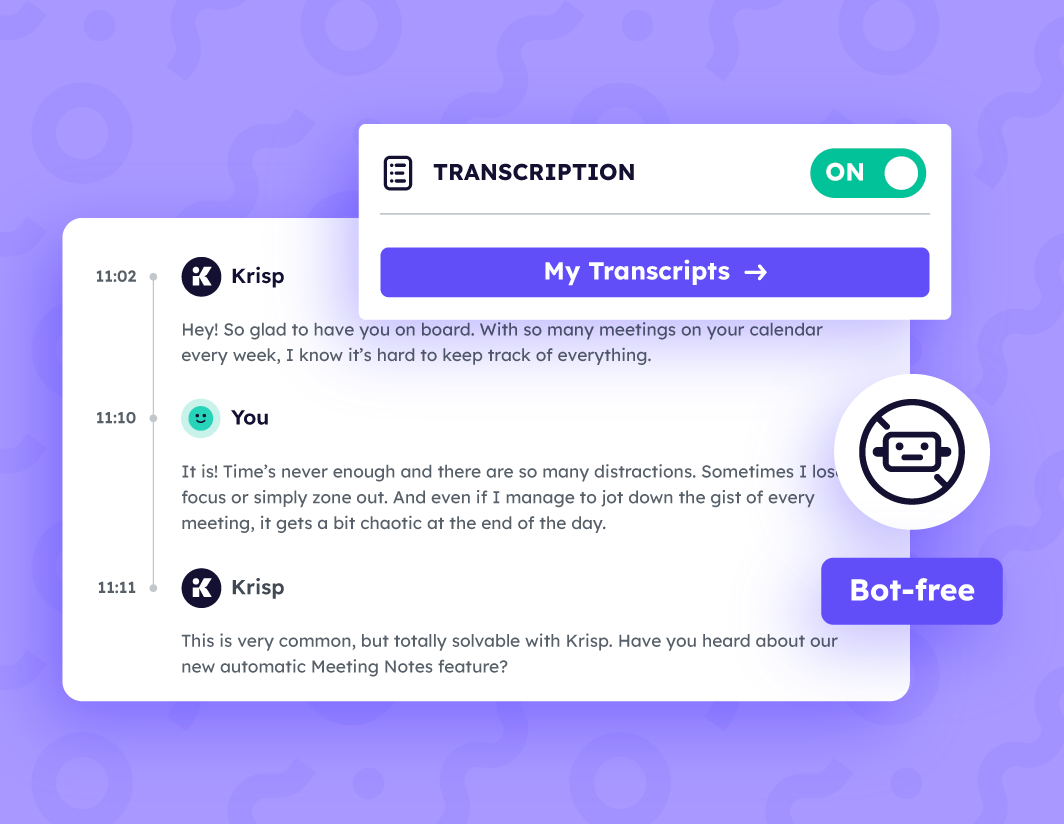Voice is rapidly becoming the dominant mode of communication through digital channels, and online meetings are at the heart of business productivity. Successful virtual meetings require clear communication and quick synthesis of key takeaways, action items, and effective follow-ups in order for them to be effective.
For meeting attendees, as well as for stakeholders that may not attend the meeting, it is imperative that accurate and timely meeting notes are captured and shared in order to maximize the visibility, clarity, and collaboration of all business discussions.
The challenge is that capturing quality meeting notes is a manual process today, and is prone to human error, subjectivity, and lack of completeness and relevance.
Automated Meeting Transcripts
Recording calls is not a new concept; it has been around since the dawn of telephony. With the rise of online meetings, call recordings have become the default mode of capturing and sharing meeting context. The emergence of cloud computing has also brought speech-to-text technology to the forefront, but it requires massive computational power to produce accurate meeting transcriptions.
The Era of Bot-Rich Meetings

Building on this foundation, a new wave of meeting notes products emerged, to create recording-based transcriptions that rely on cloud-based servers. These products introduced bots that join virtual meetings, record them, and transcribe audio using cloud-based Automatic Speech Recognition (ASR). However, this approach is laced with flaws:
- Recording Liabilities: Recording the entire meeting means recording sensitive information (voice biometrics), liability for how the recordings are handled, and compliance with various consent laws both across the U.S. and internationally.
- User Experience Disturbances: Bots joining meetings can create an awkward experience for participants, driving up latency and noticeable delays–even more so when multiple participants bring their own bots.
- Pricing & Cost Limitations: ASR on servers is expensive and often comes with feature payment walls, limiting users to transcribing only essential meetings.
- Privacy Concerns: Sending recordings to third parties increases security risks, raising valid privacy concerns.
- Transcription Quality: Transcription services often struggle to translate linguistic nuances and fail to recognize speech from background noises, leading to inaccurate transcriptions, summaries, and action items.
Try Krisp AI Meeting Assistant Now
Krisp’s Perspective
When we set out to create Krisp AI Meeting Assistant, we knew that relying on recordings was an unreasonable approach, so we dared to think differently and came up with a series of game-changing innovations:
- On-Device ASR: After two years of relentless development, we’ve crafted an on-device ASR that offers the same transcription quality as cloud-based solutions, using 15% of an Intel i5 CPU’s single core.
- Near Real-Time Transcription: Because Krisp’s app architecture is a virtual mic and speaker, we’ve made near-real-time transcription a reality without the need for audio or voice recording.
- High-Quality Automated Meeting Summarization: Our advanced system of prompts utilizes ChatGPT to generate top-notch meeting notes and automated meeting minutes that summarize key points, action items, or takeaways that are accurate and concise..
Bot-Free Meetings and Privacy

Krisp delivers a superior user experience:
- No integrations or plugins: Krisp supports all audio and voice applications out-of-the-box without the need for additional software to support specific applications.
- Voice doesn’t leave your device: Krisp is safeguarding personal information, unlike any other transcription service on the market.
- Always-On Transcriptions: Other transcription services must be manually initiated or configured to transcribe by default due to the prohibitively expensive cost of cloud transcription services. Krisp’s transcription services are on by default, giving unrestricted access to unlimited, free meeting transcriptions.
- Universal Compatibility: As a virtual mic and speaker, Krisp works with any communication app you’re using.
- High-Quality Automatic Meeting Notes: Be the office hero with professionally formatted notes, highlighting key discussion items, ETAs, and follow-ups, ready to share as soon as the meeting ends.
Krisp Meeting notes are chill and don’t make or save any audio, so there’s no personal info hanging around. But, just to be cool, we think it’s a good idea to let everyone on the call know that the meeting’s being transcribed.
ASR Technology
Krisp’s ASR technology includes a neural network with a conformer-based architecture and has exceeded a variety of industry speech recognition benchmarks.
Krisp’s neural network is trained on a large dataset of diverse audio recordings and transcriptions, which enables it to recognize a wide range of accents, dialects, and speech styles. Our model has been trained on over 70,000 hours of speech data, which encompasses a wide range of accents and dialects. The main testing metric of the ASR model is the WER (Word Error Rate). Here are the evaluation results for different noisy conditions (as decibels increase, noise energy decreases).
|
Original |
10db | 5db |
0db |
|
| Krisp |
6.94% |
8.05% | 9.47% |
13.37% |
| Otter.ai |
7.29% |
9.02% | 11.55% |
19.20% |
| Amazon |
7.26% |
8.22% | 9.36% |
12.77% |
| Whisper tiny |
9.23% |
12.34% | 16.92% |
28.2% |
| Whisper base |
7.34% |
9.49% | 12.21% |
19.67% |
Conclusion
Krisp is poised to redefine the meeting notes experience with AI-powered, on-device transcriptions and automatic note generation. Say goodbye to the limitations of the past and embrace the future of meetings with Krisp’s trailblazing, privacy-focused, and bot-free solution. Get ready for a paradigm shift in productivity!


